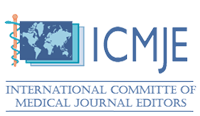ВЛИЯНИЕ НЕКРОЗА И АПОПТОЗА ЛИМФОЦИТОВ НА ВЫРАЖЕННОСТЬ ИММУННЫХ РЕАКЦИЙ
Аннотация
Процессы апоптоза и некроза являются механизмами программируемой гибели клеток, отличающиеся друг от друга механизмами их реализации. Данные процессы в пределах физиологической нормы представляют интерес в оценке их влияния на активность иммунных реакций.
Цель. Выявить характер взаимосвязи уровня некроза и апоптоза лимфоцитов периферической крови и выраженности реакций иммунной системы у практически здоровых людей.
Материалы и методы. Проведено обследование 77 человек. Клинический анализ периферической крови проведён на гематологическом анализаторе Sysmex XS-500i (Япония). Изучение содержания апоптотических и некротических клеток выполнено на проточном цитометре Epics XL (Beckman Coulter, США). ИФА в сыворотке крови определено содержание цитокинов, иммуноглобулинов (Bender MedSystems, Австрия) и серотонина (DRG, Германия). Результаты исследования обработаны с использованием пакета прикладных программ Statistica 6 (StatSoft, США).
Результаты. Установлено, что повышенный уровень некротизированных лимфоцитов сочетается с увеличением числа апоптотических лимфоцитов, Т-хелперов, лимфоцитов CD95+, IgA, IgE, IgG на фоне сокращения уровня клеток с рецепторами к белкам главного комплекса гистосовместимости класса II и к Fc-фрагменту IgE, провоспалительных цитокинов (IFN-γ, IL-6) и серотонина. Некротическая гибель не ассоциирована с клеточным цитолизом по содержанию цитотоксических Т-лимфоцитов и натуральных киллеров, но обратно взаимосвязана с реакцией фагоцитоза нейтрофилов.
Заключение. Таким образом, некротическая гибель лимфоцитов в пределах физиологических границ в отличие от апоптоза повышает активность иммунных реакций. Некрозу и апоптозу подвергаются преимущественно зрелые В-клетки с рецепторами к IgE и белкам главного комплекса гистосовместимости класса II.
Скачивания
Литература
Dobrodeeva L.K., Patrakeeva V.P. Vliyanie migratsionnykh i proliferativnykh protsessov limfotsitov na sostoyanie immunnogo fona cheloveka, prozhivayushchego v usloviyakh vysokikh shirot [Influence of migration and proliferative processes of lymphocytes on the state of the immune background of a person living in conditions of high latitudes]. Ekaterinburg: UrO RAN, 2018, 203 p.
Potapnev M.P. Autofagiya, apoptoz, nekroz kletok i immunnoe raspoznavanie svoego i chuzhogo [Autophagy, apoptosis, cell necrosis and immune recognition of self and alien]. Immunologiya, 2014, vol. 35, no. 2, pp. 95−102.
Todorov Y. Klinicheskie laboratornye issledovaniya v pediatrii [Clinical laboratory research in pediatrics]. Sofiya : Meditsina i fizkul’tura, 1968, 1064 p.
Khaitov R.M., Man’ko V.M., Yarilin A.A. Vnutrikletochnye signal’nye puti, aktiviruyushchie ili ingibiruyushchie funktsii kletok immunnoy sistemy. 3. Formirovanie i regulyatsiya signal’nykh putey, indutsiruemykh aktivatsiey antigenraspoznayushchikh retseptornykh struktur T- i V-limfotsitov [Intracellular signaling pathways that activate or inhibit the functions of cells of the immune system. 3. Formation and regulation of signaling pathways induced by activation of antigen-recognizing receptor structures of T- and B-lymphocytes]. Uspekhi sovremennoy biologii, 2005, vol. 125, no. 6, pp. 544-554.
Chereshnev V.A., Frolov B.A., Belyaeva N.M. et al. Molekulyarnye mekhanizmy vospaleniya [Molecular mechanisms of inflammation] / ed. V.A. Chereshnev. Ekaterinburg: UrO RAN, 2010, 262 p.
Abdouh M., Albert P.R., Drobetsky E. et al. 5-HT1A-mediated promotion of mitogen-activated T and B cell survival and proliferation is associated with increased translocation of NF-kappaB to the nucleus. Brain Behav. Immun., 2004, vol. 18, pp. 24–34. https://doi.org/10.1016/s0889-1591(03)00088-6
Atsumi T., Sato M., Kamimura D. IFN-γ expression in CD8+ T cells regulated by IL-6 signal is involved in superantigen-mediated CD4+ T cells death. Int. Immunol., 2009, vol. 21, no. 1, pp. 73-80. https://doi.org/10.1093/intimm/dxn125
Coccia E.M., Rigamonti L. et al. Interferon-gamma receptor 2 expression as the deciding factor in human T, B, and myeloid cell proliferation or death. J. Leukoc. Biol., 2001, vol. 70, no. 6, pp. 950–960. https://jlb.onlinelibrary.wiley.com/doi/10.1189/jlb.70.6.950
Bottcher A., Gaipl U.S., Furnrohr B.G. et al. Involvement of phosphatidylserine, αvβ3, CD14, CD36, and complement C1q in the phagocytosis of primary necrotic lymphocytes by macrophages. Arthritis & Rheumatology, 2006, vol. 54, no. 3, pp. 927-938. https://doi.org/10.1002/art.21660
Brown G.D., Willment J.A., Whitehead L. C-type lectins in immunity and homeostasis. Nat. Rev. Immunol., 2018, vol. 18, pp. 374-389. https://doi.org/10.1038/s41577-018-0004-8
Bustin M. At the crossroads of necrosis and apoptosis: signaling to multipl cellular targets by HMGB1. Science Signaling, 2002, vol. 2002, no. 151, pp. 39. https://doi.org/10.1126/stke.2002.151.pe39
Chen G.Y., Nunez G. Sterile inflammation: sensing and reacting to damage. Nature Rev. Immunol., 2010, vol. 10, pp. 826–837. https://doi.org/10.1038/nri2873
Dustin M.L. Help to go: T cells transfer CD40L to antigen-presenting B cells. Eur. J. Immunol., 2017, vol. 47, no. 1, pp. 31-34. https://doi.org/10.1002/eji.201646786
Gardell J.L., Parker D.C. CD40L is transferred to antigen-presenting B cells during delivery of T-cell help. European J. of Immunology, 2017, vol. 47, no. 1, pp. 41-50. https://doi.org/10.1002/eji.201646786
Golstein P., Kroemer G. Cell death by necrosis: towards a molecular definition. Trends Biochem. Sci., 2007, vol. 32, no. 1, pp. 37-43. https://doi.org/10.1016/j.tibs.2006.11.001
Lahoz-Beneytez J., Elemans M., Zhang Y. et al. Human neutrophil kinetics: modeling of stable isotope labeling data supports short blood neutrophil half-lives. Blood, 2016, vol. 127, no. 26, pp. 3431-3438. https://doi.org/10.1182/blood-2016-03-700336
Lai J.-J., Cruz F.M., Rock K.L. Immune sensing of cell death through recognition of histone sequence by C-type lectin-receptor-2d causes inflamation and tisssue injure. Immunity, 2019, vol. 52, no. 1, pp. 123-135. https://doi.org/10.1016/j.immuni.2019.11.013
Lu J., Wu J., Xie F. et al. CD4+ T cell-released extracellular vesicles potentiate the efficacy of the HBsAg vaccine by enhancing B cell responses. Advanced Science, 2019, vol. 6, no. 23, 1802219. https://doi.org/10.1002/advs.201802219
Orr Y., Wilson D.P., Taylor J.M. et al. A kinetic model of bone marrow neutrophil production that characterizes late phenotypic maturation. Am. J. Physiol. Regul. Integr. Comp. Physiol., 2006, vol. 292, no. 4, R1707-16. https://doi.org/10.1152/ajpregu.00627.2006
Rosales C. Neutrophils at the crossroads of innate and adaptive immunity. J. of Leukocyte Biology, 2020, vol. 108, no. 1, pp. 377-396. https://doi.org/10.1002/JLB.4MIR0220-574RR
Servais F.A., Kirchmeyer M. et al. Modulation of the IL-6-Signaling Pathway in Liver Cells by miRNAs Targeting gp130, JAK1, and/or STAT3. Mol Ther Nucleic Acids, 2019, vol. 16, pp. 419-433. https://doi.org/10.1016/j.omtn.2019.03.007
Schuff-Werner P., Splettstoesser W. Antioxidative properties of serotonin and the bactericidal function of polymorphonuclear phagocytes. Adv. Exp. Med. Biol., 1999, vol. 467, pp. 321–325. https://doi.org/10.1007/978-1-4615-4709-9_41
Vanlangenakker N., Berghe T.V., Krysko D.V. et al. Molecular mechanisms and pathophysiology of necrotic cell death. Curr. Mol. Med., 2008, vol. 8, no. 3, pp. 207-220. https://doi.org/10.2174/156652408784221306
Wu H., Denna T.H., Storkersen J.N., Gerriets V.A. Beyond a neurotransmitter: The role of serotonin in inflammation and immunity. Pharmacol. Res., 2019, vol. 140, pp. 100-114. https://doi.org/10.1016/j.phrs.2018.06.015
Wu H., Denna T.H., Storkersen J.N., Gerriets V.A. Beyond a neurotransmitter: The role of serotonin in inflammation and immunity. Pharmacol. Res., 2019, vol. 140, pp. 100-114. https://doi.org/10.1016/j.phrs.2018.06.015
Zhu H., Yoshimoto T., Yamashima T. Heat shock protein 70.1 (Hsp70.1) affects neuronal cell fate by regulating lysosomal acid sphingomyelinase. J Biol Chem., 2014, vol. 289, pp. 27432-27443. https://doi.org/10.1074/jbc.M114.560334
Просмотров аннотации: 367 Загрузок PDF: 248
Copyright (c) 2021 Ol’ga A. Stavinskaya, Liliya K. Dobrodeeva, Veronika V. Patrakeeva

Это произведение доступно по лицензии Creative Commons «Attribution-NonCommercial-NoDerivatives» («Атрибуция — Некоммерческое использование — Без производных произведений») 4.0 Всемирная.






















































